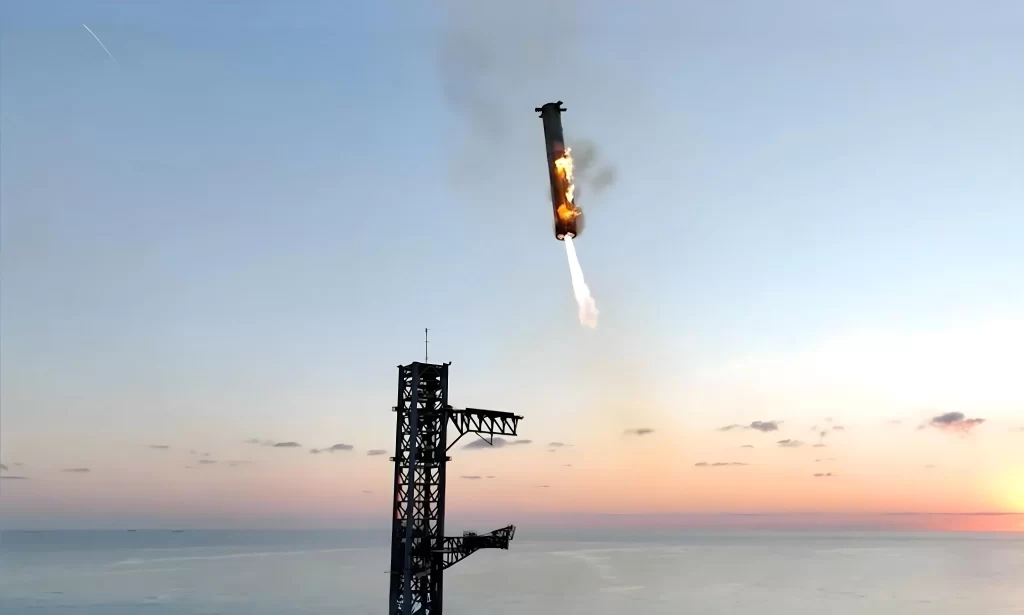Introduction:
SpaceX has taken a significant step toward revolutionising space travel by catching the 70-meter-long booster of its Starship rocket with robotic arms, dubbed “Mechazilla.” This development brings Elon Musk’s company closer to creating a fully reusable rocket system, a crucial innovation for reducing the cost and time associated with space launches.
What Happened:
On Sunday, SpaceX successfully tested its Starship rocket system, marking a milestone in its mission to make space travel more efficient. During the fifth test launch of the Starship system, the first-stage booster, known as Super Heavy, was caught mid-air by two massive robotic arms. This advancement is key to Musk’s vision of a reusable space vehicle.
What is Starship?
Starship is a two-stage heavy-lift rocket system designed to carry cargo and crew to various celestial destinations, including Earth orbit, the Moon, Mars, and beyond. The system consists of two parts: the Super Heavy booster and the Starship spacecraft, which together stand nearly 120 meters tall—making it the largest rocket ever built, even surpassing the 111-meter Saturn V, which took astronauts to the Moon.
For context, the Qutab Minar in India is approximately 72.5 meters tall, close to the length of the booster that was caught during this mission. Once fully operational, Starship has the potential to revolutionise space travel by making trips more frequent and cost-effective.
The Launch:
The rocket system launched from SpaceX’s Starbase in Boca Chica, Texas, at 7:25 a.m. local time. Powered by Super Heavy’s 33 methane-fueled Raptor engines, this was the fifth test for the Starship system. About three minutes and forty seconds into the flight, the booster separated from the upper-stage Starship spacecraft and flipped mid-air. It reignited 13 of its engines to slow its descent as it returned to the Texas coast.
Unlike traditional boosters that splash down in the ocean, SpaceX aimed to safely land the Super Heavy booster at the launch site. It reduced its speed from over 27,350 km/h, descended at an angle, then straightened up as it neared the launch gantry. The gantry, equipped with robotic arms dubbed “Mechazilla,” caught the descending booster, which then shut down its engines.
Meanwhile, the Starship spacecraft continued its journey into space. It completed one orbit around Earth before successfully performing a controlled splashdown in the Indian Ocean.
Why This Test Matters:
Most rocket systems today are expendable, meaning they are used once and discarded, making space missions expensive and time-consuming. SpaceX’s goal is to change this by developing a fully reusable system. The ability to catch and reuse the Super Heavy booster marks a critical milestone in achieving this objective. Elon Musk envisions that Mechazilla will eventually be able to return a rocket to the launchpad in as little as 30 minutes, allowing for rapid turnaround between missions.
Musk explained in an interview with Everyday Astronaut that Mechazilla is central to this vision of reusability. “His goal is for the system to stack a Starship back onto the booster almost immediately after landing,” cutting down the downtime between flights.
This achievement builds on SpaceX’s prior success with the Falcon 9, a smaller rocket that lands on platforms using legs. However, the method for Starship is more ambitious, as it involves catching the rocket in mid-air without the use of landing legs.
Starship’s Role in Future Space Exploration:
Starship is essential for SpaceX’s long-term goals in space exploration, particularly its plans to take astronauts and cargo to the Moon and Mars. NASA has contracted SpaceX to develop a version of Starship, known as the Human Landing System (HLS), to transport astronauts back to the Moon by 2026 as part of the Artemis III mission. The contract is valued at up to $4 billion, as reported by CNN.
Eventually, SpaceX aims for Starship to be the first rocket to carry humans to Mars, turning the ambitious dream of interplanetary travel into reality. However, before embarking on these missions, SpaceX must prove that Starship is both safe and cost-effective, a challenging task given the history of spaceflight programs.
NASA’s Space Shuttle program, which ended in 2011, aimed to develop reusable spacecraft. While partially successful, the costs of refurbishing and maintaining shuttles far exceeded those of launching expendable rockets. SpaceX is hoping to overcome these challenges with its fully reusable Starship system, dramatically reducing costs.
SpaceX’s success in catching the Starship booster with Mechazilla is a game-changing moment in the quest for reusable rockets. As the company continues to refine this technology, it moves closer to its goal of frequent, affordable space travel—eventually paving the way for missions to the Moon, Mars, and beyond.

